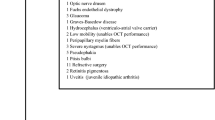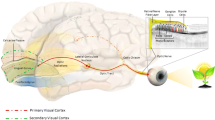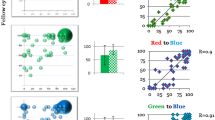Abstract
Objective
To assess the type and degree of both red–green and blue–yellow color vision deficiencies of Calabrian males affected by multiple sclerosis.
Material
Eighty Calabrian male patients were enrolled (age range 18–70 years; mean age 40.6 ± 12.4 years) showing a disease duration mean of 10.6 ± 8.2 years (range = 0.5–46 years) coming from the Institute of Neurology, Magna Graecia University, Catanzaro. Optic neuritis present in the medical histories of the 21 patients does not influence color vision. Excluding seven colorblind subjects and one affected by a bilateral maculopathy, the analyzed sample group was 72. Seventy controls were matched for age and sex.
Method
An ophthalmologist examined all patients and controls in order to rule out diabetic retinopathy, cataracts, senile maculopathy, or ocular fundus’ anomalies. The Ishihara test identified the colorblind patients. The City University Test screened for people with abnormal color vision by grading the severity of color vision deficiency. The second part of the City University Test as well as the Farnsworth Test confirmed both the color vision deficiency type and degree.
Results
Fifty-one percentage (37/72) of the patients showing a color vision deficiency were subdivided into two subgroups: subgroup one showed red–green deficiency (57%, 21/37); subgroup two showed a coupled red–green and blue–yellow deficiency (43%, 16/37). Furthermore, we found two distinct curves showing a groove within the first 10 years of the disease. Both monocular and binocular analyses allowed us to identify the patients showing the monocular color vision deficiency, but they were well compensated by binocular vision.
Conclusion
We think that the majority of the patients with the red–green deficiency will develop the coupled red–green and blue–yellow deficiency in the latter years of multiple sclerosis.
Similar content being viewed by others
Avoid common mistakes on your manuscript.
Introduction
The study of color vision is instrumental in understanding the cerebral processes involved in vision [1]. Acquired color vision deficiency can be a result of ocular or general pathology, intracranial injury, or the prolonged use of some therapeutic drugs. The abnormality can originate anywhere along the visual pathway, from the retinal receptors to the visual cortex, and it can be biologically verified [2]. The severity of acquired color vision deficiency changes with time, in step with the causative pathology, and monocular or binocular differences are often found [2, 3]. Moreover, in some neurological diseases, monitoring color vision changes assists with medical diagnosis and may suggest when therapeutic measures should begin or be discontinued [1,2,3]. There are three types of acquired color vision deficiency [2]. Type 1 occurs in receptor dystrophies that affect central cones. Loss of central cones produces a Purkinje-like shift in the wavelength of maximum relative luminous efficiency because rod responses become dominant causing “scotopic vision.” Type 2 occurs in some lesions of the optic nerve and generally in demyelinating diseases, which cause a defective electrical conduction along the red–green axis without altering the wavelength of maximum relative luminous efficiency. Cone dystrophies and optic nerve lesions may be difficult to distinguish clinically since both abnormalities produce reduced visual acuity and central field defects. Therefore, the type of acquired red–green color deficiency may be of diagnostic importance. Type 3 resembles a congenital tritan deficiency, and the patients are not able to match violet and yellow–green wavelengths. However, in acquired color vision deficiency, there is a greater reduction in sensitivity at both the short and long wavelengths, and the wavelengths of maximum relative luminous efficiency may shift toward shorter wavelengths, as a pseudoprotanomaly [2].
The aim of the present work is to assess the type and degree of both red–green and blue–yellow color vision deficiency in Calabrian males affected by multiple sclerosis. Within the boundaries of a large investigation on acquired color vision deficiency in neurodegenerative diseases and, in a special way, after the results obtained in Parkinson’s disease [4], other Authors [5, 6] underlined their difficulties in identifying acquired color vision deficiency in multiple sclerosis.
Patients
Eighty Calabrian male patients (age range 18–70 years; mean age, 40.6 ± 12.4 years) showing a mean disease duration of 10.6 ± 8.2 years (range 0.5–46 years) admitted to the Institute of Neurology, Magna University, Catanzaro (Calabria, Southern Italy) were enrolled in this study. Seventy control subjects were matched for age and sex. An ophthalmologist examined all patients and controls in order to rule out diabetic retinopathy, cataracts, senile maculopathy, or ocular fundus anomalies. We excluded from the results analysis seven colorblind patients (three deuteranopous, three deuteranomalous, one protanopous) and one patient affected by bilateral maculopathy. The analyzed sample was 72 patients. Twenty-nine percentage (21/72) of the patients reported optic neuritis episodes in their medical histories. Fixed sampling of males, as in our previous work on color vision in Parkinson’s disease [4], allowed us to avoid the genetic Lyon phenomenon [7], which is present only in the heterozygous females for X-linked diseases such as colorblindness (the inherited red–green color vision deficiency). Therefore, the exclusion of females in our sample allowed us to avoid those heterozygous colorblind females who would be “false positives” for the acquired red–green color vision deficiency caused by multiple sclerosis, thus altering the results analysis. The Authors showed an 8% of red–green inherited colorblindness frequency in Calabrian people [8]. If we had not considered this frequency we would have found a relatively significant high number of “false positive” subjects showing a red–green color vision trend, which, as in a Gaussian curve, can carry a minimum value (normal color vision) to a maximum value miming the inherited red–green colorblindness, passing for different anomalous color vision levels. The relatively high frequency of the inherited red–green colorblind females united Lyon genetic presence by the heterozygous females for the inherited red–green colorblindness should be the real cause to mistake discriminating between the red–green inherited colorblindness and that acquired due to multiple sclerosis. We should not comprehend if homozygous female status is really inherited or acquired; and in heterozygous status we miss all those females miming the normal color vision. The acquired color vision deficiency is real in the males cohort because they have not the compensation presence by second X chromosome, and the anomaly has not hidden. Moreover, the Authors know that multiple sclerosis is a disease showing a relatively high females incidence [9,10,11,12]. But, in the present work the Authors pay their attention to a parameter, the color vision, that cannot be studied in the females cohort due to the above genetic reasons. Choosing a statistically valid number of males showing a pure acquired color vision deficiency without any genetic influence is the result of a precise and relatively long selection (2015–2017 years).
Methods
All patients and controls underwent the following tests: Ishihara Test [13], which is the most reliable [14] among the pseudoisochromatic tests to identify colorblind subjects (for inherited red color vision deficiency, protanopy or protanomaly; for inherited green color vision deficiency, deuteranopy or deuteranomaly). Patients who made more than five errors reading the first 17 plates were diagnosed as being colorblind. The type of colorblindness was determined by reading the last four tables. Farnsworth Dichotomous D-15 Test [15] identified both the greatness of color vision deficiency by the high number of errors (maximum value, n. 15) and the type (deutan, protan, or tritan). The City University Test [16] identified (both binocularly and monocularly) people with different types and degrees of the acquired red–green deficiency (maximum value of errors number, n. 6) and blue–yellow color vision deficiency (maximum value of errors number, n. 3).
Results
Acquired color vision deficiency was present in 51% (37/72) of the patients. Particularly, 57% (21/37) of these showed the acquired red–green color vision deficiency, while 43% (16/37) showed the coupled red–green and blue–yellow acquired color vision deficiency. Considering the “disease duration” parameter, 10 years was the cutoff allowing the subdivision into the two above groups. More precisely, the 21 patients showing the acquired red–green color vision deficiency were within in first 9 years of the disease, and they could enter the second group of the acquired red–green color vision deficiency coupled to the blue–yellow, considered late disease age (11–46 years) of multiple sclerosis. We aim to confirm this result in our follow-up study. Seven out of 21 patients with the acquired red–green color vision deficiency presented monocularly in the left or right eye and retained a normal binocular vision. Only five out of 16 patients with the defect for both axes presented monocularly in the left or right eye, also retaining a normal binocular vision. This result shows the importance of both monocular and binocular analysis. Table 1 shows the errors made by the two sample groups reading the tests with both monocular and binocular vision related to disease duration. Moreover, the error scores for the Farnsworth D-15 test were calculated by Bela Torok analysis showing higher mean value (23.0 ± 7.9) for the subjects with coupled red–green and blue–yellow color vision deficiency than the mean value (15.7 ± 7.0) for the subjects with red–green color vision deficiency. The t test was 2.96 (0.01 < p < 0.001).
The optic neuritis episodes reported in the medical histories of 21 patients do not influence color vision because 9/21 had no color vision deficiency and 12/21 subdivided into two groups: 5/12 with red–green color vision deficiency and 7/12 with red–green color vision deficiency coupled with blue–yellow.
The 70 control subjects, without any inherited color vision impairment or acquired color vision impairment, showed normal color vision after undergoing the three tests.
Discussion
Acquired color vision deficiency differs qualitatively from congenital color vision deficiency because color opponent mechanisms are involved, as in multiple sclerosis. Acquired color vision deficiency is therefore less easy to classify and specific defects lack features associated with more than one type of congenital color vision deficiency. Often this vision deficiency results in reduced visual acuity and field. Color vision may vary sectorially in an affected eye [2]. In some cases, the discrimination between blue–yellow color vision deficiency from that of red–green is difficult, and according to Kollner’s rule we know that “defects of blue–yellow color vision are caused by retinal disease and defects of red–green color vision are due to optic nerve disease” [17]. The results of modern examination techniques generally support Kollner’s rule. Printed pseudoisochromatic plates are the most widely used screening tests for abnormal color vision. Most tests aim to identify congenital or inherited red–green color deficiency only, and some are highly efficient. Identification of tritan defects is confounded by variations in macular pigment and lens density and lower values of specificity and sensitivity have to be acceptable [2]. Ishihara test is remarkably efficient as a screening test for inherited red and green defects, but does not test the blue anomalies [3]. Opinions of the Hardy, Rand and Rittler (HRR) test varied; Walls [18] made trenchant criticisms that the test was liable to misdiagnosis between protan and deutan; Dreyer [19] noted poor diagnostic ability; Hardy et al. [20] do not report having given their test to the rare tritan observers. Dvorine [21] showed as in his test 14 plates with numbers and 7 with tracks enabled protan and deutan differentiation to be attempted. But, after criticism by Sloan [22], also Lakowsky [23] pointed out the reason for Dvorine plates to be “failed” in a tritan manner by many subjects over 40 years of age, in the special way. Unsazume and Matsuo [24] gave a relatively high accuracy for protans and deutans identification for their Tokio Medical College plates, but also in this case some criticism is present, as Vos [25] who pointed out some of the difficulties in using it. Among the rarely used pseudoisochromatic plates which have poor screening efficiency [2], we remember the Ohkuma plates, the Standard Pseudoisochromatic Plates (SPP1 e SPP2), the American Optical Color Vision Test, the Hahn Color Vision Test, the Lanthony Tritan Album. The development of fluorescein angiography, electro-diagnostic techniques, and nuclear resonance imaging has led to more precise clinical diagnosis, and it is possible to link acquired color vision deficiency with a type of pathology rather than a broad classification of disease. Computerized examination techniques, which examine peripheral color vision or isolate chromatic and achromatic responses, have been developed specifically for acquired color vision deficiency [2]. These methods, however, are unique to a specific research laboratory due to the expensive equipment. So, choosing to operate by the pseudoisochromatic tests shown in the present work means to choose a noninvasive and inexpensive method of analysis. Generally, poor visual acuity and central, or paracentral field as in the demyelinating diseases, deficiencies limit performance on some pseudoisochromatic plates. Therefore, according to the bibliography [2, 14], choosing the three tests [13, 15, 16] using binocular and monocular vision allowed us to distinctly identify the two groups in multiple sclerosis giving, we hope, a useful contribution to the Ophthalmological and Neurological bibliography.
Conclusion
The Authors believe that the present work can be useful for future studies on acquired color vision deficiency, and it can fill a void in the understanding of the acquired color vision deficiency in multiple sclerosis. We wish respond to the appeal by some Authors [6] who, at the end of their own works, because of the impossibility to identify red–green color vision deficiency and sampling only blue–yellow deficient females affected by multiple sclerosis, said, “Future studies should seek to better understand the differences between these two deficiencies.” We could think that Lampert et al. [6] failed identifying the two groups for multiple sclerosis about their color vision because they sampled only the females; moreover, the use of HRR plates, the Richmond HRR test, showing an unsatisfactory color design and the test is not recommended for clinical use [26].
References
Zeki S (1993) A vision of the brain. Blackwell Scientific Publication, Oxford
Birch J (2001) Diagnosis of defective colour vision. Butterworth-Heinemann, Oxford
Fletcher R, Voke J (1885) Defective color vision. Fundamentals, diagnosis and management. A. Hilger, Bristol
Piro A, Tagarelli A, Nicoletti G, Fletcher R, Quattrone A (2014) Color vision impairment in Parkinson’s disease. J Parkinson Dis 4:317–319
Cole BL, Lian KY, Lakkis C (2006) The new Richmond HRR pseudoisochromatic test for colour vision is better than the Ishihara test. Clin Exp Optom 89:73–80
Lampert EJ, Andorra M, Torres-Torres R, Ortiz-Pèrez S, Llufriu S, Sepulveda S, Sola N, Saiz A, Sanchez-Dalmau B, Villoslada P, Martinez-Lapiscina Elena H (2015) Color vision impairment in Multiple Sclerosis points to retinal ganglion cell damage. J Neurol 262:2491–2497
Lyon MF (1961) Gene action in the X-chromosome of the mouse (Mus musculus L.). Nature 190:372–373
Tagarelli A, Piro A, Tagarelli G, Zinno F (2000) Color-blindness in Calabria (Southern Italy): a north–south decreasing trend. Am J Hum Biol 12:17–24
Kurtzke JF, Beebe GW, Norman JE (1979) Epidemiology of Multiple Sclerosis in U.S. veterans: 1. Race, sex, and geographic distribution. Neurology 29:1228–1235
Pugliatti M, Rosati G, Carton H, Riise T, Drulovic J, Vécsei L, Milanov I (2006) The epidemiology of Multiple Sclerosis in Europe. Eur J Neurol 13:700–722
Dunn SE, Lee H, Pavri FR, Zhang MA (2015) Sex-based differences in Multiple Sclerosis (part I): biology of disease incidence. Curr Top Behav Neurosci 26:29–56
Ramien C, Taenzer A, Lupu A, Heckmann N, Engler JB, Patas K, Friese MA, Gold SM (2016) Sex effects on inflammatory and neurodegenerative processes in Multiple Sclerosis. Neurosci Biobehav Rev 67:137–146
Ishihara S (1982) The series of plates designed as a test of colour-blindness, 38 Plates edn. Kanehara S. Co., Ltd., Tokyo
Long GM, Lyman BJ, Tuck JP (1985) Distance, duration and blur effects on the perception of pseudoisochromatic stimuli. Opthalmic Physiol Opt 5:185–194
Farnsworth D (1943) The Farnsworth-Munsell 100 Hue and dichotomous test for color vision. J Opt Soc Am 33:568–578
Fletcher RJ (1975) The city university color vision test, 3rd edn. Keeler Instruments, London
Kollner H (1912) Die Störungen des Farbensinners.ihre Klinische bedeutung und ihre diagnose. Berlin: Karger
Walls GL (1942) How good is the H.R.R. test for color blondness? Am J Optom 36:169–193
Dreyer V (1969) Occupational possibilities of colour defectives. Acta Ophthalmol 47:523–534
Hardy LH, Rand G, Rittler MC (1954) H-R-R polychromatic plates. J Opt Soc Am 44(7):509–523
Dvorine I (1963) Quantitative classification of the colour blind. Gen Psychol 68:255–265
Sloan LL (1945) Improved screening test for red–green color deficiency composed of available P.I.C. plates. J Opt Soc Am 35:761–766
Lakowski R (1966) A critical evaluation of colour vision tests. Br J Physiol Opt 23:186–209
Umazume K, Matsuo H (1962) Tokyo Medical College test for colour vision. Die Farbe 11(1/6):45–47
Vos JJ (1972) Literature review of human macular absorption in the visible spectrum and its consequences for the cone receptor primaries. Report. Institute for Perception TNO, Soesterberg
Birch J (1997) Clinical use of the American Optical Company (Hardy, Rand and Rittler) pseudoisochromatic plates. Ophthal Physiol Opt 17:248–254
Author information
Authors and Affiliations
Corresponding author
Ethics declarations
Conflict of interest
All authors declare that they have no conflict of interest.
Ethical approval
This article contains not invasive study on patients all admitted in the Institute of Neurology, Magna Graecia University.
Informed consent
Informed consent is not needed because the patients are all admitted in the Institute of Neurology, Magna Graecia University reporting on their own medical histories.
Rights and permissions
About this article
Cite this article
Piro, A., Tagarelli, A., Nicoletti, G. et al. Impairment of acquired color vision in multiple sclerosis: an early diagnostic sign linked to the greatness of disease. Int Ophthalmol 39, 671–676 (2019). https://doi.org/10.1007/s10792-018-0838-x
Received:
Accepted:
Published:
Issue Date:
DOI: https://doi.org/10.1007/s10792-018-0838-x




